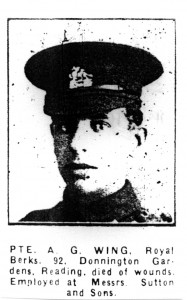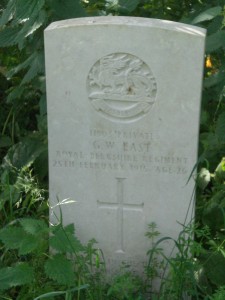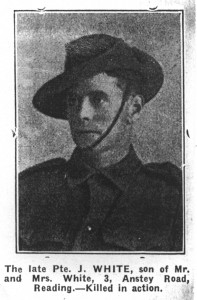John Henderson White
Private 2662
1st/4th Royal Berkshire Regt.
Division 79 Extension
John Henderson White was the son of Mr John Henderson White and Mrs Eliza White. When the CWGC register was compled the family lived at 3, Anstey Road, Reading. The 1911 census indicates that the family were living at 11. Curson Street,Reading. John was the eldest of three brothers living at home at the time. His occupation at 17 was that of a commercial clerk at the biscuit factory, Huntley and Palmers; brother William aged 15 was an insurance clerk and Henry aged 13 was still at school. The boys had an older sister Eliza Mary,also born in India, who was not living at home.
The boys had been born in India where their father was serving in the army. Now an Army Pensioner John Henderson White senior was working as a store keeper for a printing company. He was discharged from his service with Royal Engineers with a medal for long service and good conduct. His military record stated that he was very good at lithography. When the war started John Henderson senior once again enlisted for service. Comprehensive military records are avaiable on Ancestry UK.
A letter thought to be written by John was published in the Reading Standard 12th June 1915. (The letter gives the initial a S. H. White, No. 10 Platoon “C” Company)
Our Snipers Bring Shown a Saxon Flag
“Peace is declared. You no fire on us, then we no fire on you.”
This is what some of the Germans shouted across to the trench occupied by members of the 1st/4th battalion.
I am still in the pink of condition and enjoying myself somewhere in Belgium. I have got quite used to this life. Although it is rough at times and food is sometimes short I must admit I am much better for it and have got to like it.
A sentry informs us that the Germans opposite us have put a Saxon flag on a tree stump. I don’t know how they got it up there, for if one of them dares to put his head above the parapet he generally takes an ounce of lead down on him.. Our snipers have started now, so the flag will have a short flutter. A German got out of the trench for some unknown reason on Thursday and they had to send two stretcher bearers to fetch him in. We did not fire on them. By reports we have had here lately from all along the line things seem to be looking much better. Everyone out here will be glad when peace is declared.
The Germans often sing English songs to us in the moonlight, “Who were you with last night” being the favourite.
I am just going to turn in for forty winks now. We eat and sleep all day and work all night.
John White was killed in action on 14th August 1916, aged 22. He is commemorated on the grave of Eliza White. Number 16716. John has no known grave and he is commemorated on the Thiepval Memorial to the Missing Pier and Face 11D. Below is an account of the action in which he was killed taken from the author’s unpublished work “The School, The Master, The Boys and the V.C.”
“On the night of the 12th August 1916 the 5th battalion Royal Berkshire Regt., had taken the Germans by surprise and seized “Ridge Trench” on the crest of the hill near Thiepval. On the morning of the 13th August the 5th Royal Berks., were relieved by the 4th Oxfords with the 1st/4th’s Royal Berks., in support. At 9.30p.m.* the Oxfords gave notice that the Germans were trying to bomb them out of the trench. Two platoons from the Berkshire battalion, numbers 1 and 2, were sent forward to supply the Oxfords with bombs. “D” company was put under the command of the Oxfords Colonel with a further supply of bombs. The Oxfords were due to lead a counter attack but it was the 1st/4th’s who were eventually given the command to lead. In a manner typical in the chaos of the war, a barrage planned for before the attack did not take place and later, without detailed orders, the Berkshire men tried to cross the 250 yards of open ground facing the Germans.
The Germans, relatively safe and protected in their trenches, were able to shoot unhindered on the advancing lines of men. The image is one frequently painted during the Great War. For the survivors of the attack, shelter was poor but fortunately a British aeroplane responded to signal flares and as a result British artillery opened up on the German trenches and the remaining Berkshire men were able to get to safety. Losses for this flawed action were very high, 140 casualties from the ranks including 59 killed and missing. Petre in his history of the Royal Berkshire Regiment, comments in his account that, “Failure is often more heroic than success, and these loyal men fought and died with great honour”.


